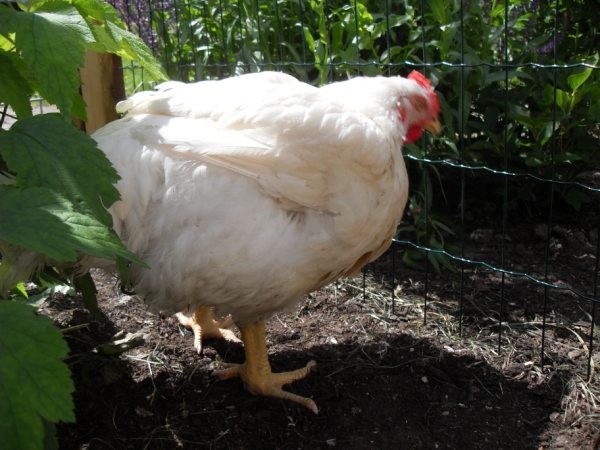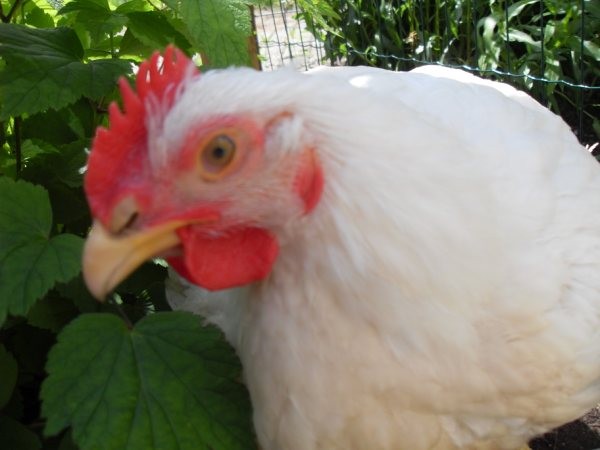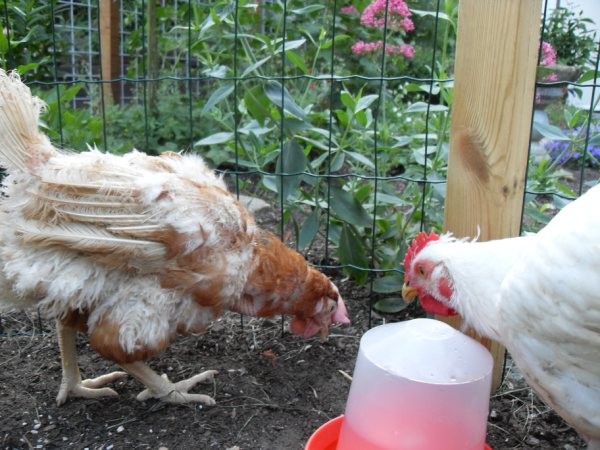Kakel
(de Nederlandse versie van het hele verhaal van Kakel is hier te lezen)
The cheap chicken that you get from the supermarket actually is no chicken at all. These 'chickens' are in fact chicks, that aren't more than six weeks old. In those few weeks these animals grow from a fluffy little chick into a lump of meat weighing about 2.5 kilos. In the Netherlands alone about 400 million chicks are reared every year for their meat.
When the chicks hatch in a hatchery they go directly to fattening farms, where they end up in a big barn without windows with more than 16 to 24 animals per square meter.
Initially the animals have enough room to move, but after a few weeks the house is filled with chickens. There is hardly any room for them to spread their wings, clean their feathers and scratch in the ground. They will never see any sunlight apart from on their way to the slaughterhouse.
Broilers are bred to grow fast, to get big thighs and a lot of breastmeat. In the 50's it took 13 weeks to get 2 kilos of chicken. Now chickenmeat is produced twice as fast. This selective breeding leads to a lot of casualties. Millions of animals die of organ failure or starvation because they can not reach the water and food containers anymore. In the end their legs are too weak to support their heavy bodies so that they can barely walk.
When the animals have reached their slaughter weight, they are caught by a special team or with a catching machine. Within a few hours, thousands of chickens are crammed into crates.
On 28 May 2010, a truck laden with crates full of chickens was on its way to the slaughterhouse in Zevenhuizen (the Netherlands). Due to unknown circumstances, that I can only guess at, one of these chickens had fallen from its crate onto the road, the N219. And there she was sitting for who knows how long in the burning sun. Nobody had seen her or picked her up.
And then I drove past.
Of course I took the chicken off the road and took her home with me. She looked awful: dirty, bald and very scared.
I went to the vet and asked him to put the poor animal to sleep, but the vet thought we should give her another chance. And so I did!
In no time we had made a little run in the garden, purchased a nighthouse and bought some chicken feed. It took her three days to stand up. Her misformed legs could not carry her heavy body. She was afraid of everything around her. She had never seen the sun.
We gave her a worm. At first she did not know what it was and what to do with it. She hesitated and finally she ate the worm. The second and third worm were devoured without hesitation.
Three weeks later: Kakel (that's how we named her) had finally cleaned her remaining feathers. She looked shiny and, on her bare body, new fluffy feathers had started to grow. In the end she was white again! Her comb was no longer an anaemic pink but had become bright red. She scratched the ground, she ate insects and worms, she ate from plants. On her own she went to her nighthouse every evening when it was dark and every morning she came out again. She took a "dust bath" in the sand. She was not afraid of all the sounds anymore. She was curious and affectionate.
She couldn't run very fast. But finally she could behave like a chicken! And then suddenly she began to crow. Apparently, Kakel was not a hen but a cockerel. For us that wasn't a problem. But the neighbours weren't very happy with him. So since a few weeks Kakel lives in a goose resort in Coevorden. I am sorry that we had to let him go, but this is the best solution for him. He has the best time of his life!
Dear all, please realise that it only costs a farmer 34 eurocents to raise a chick in 6 weeks to get 2.5 to 3 kg of chicken. The butcher pays 50 cents per hen. A live chicken is worth no more than 50 cents! Just because we want to eat cheap chicken.
Chickens suffer the most in factory farming in the Netherlands. So if after reading this story, you would like to do something for these chicks, please from now on only buy organic chicken. At least the life of these chickens is a little less miserable. It costs a bit more but hey, isn't it worth it to give these young animals at least a happy life before they die?
Back to poultry


